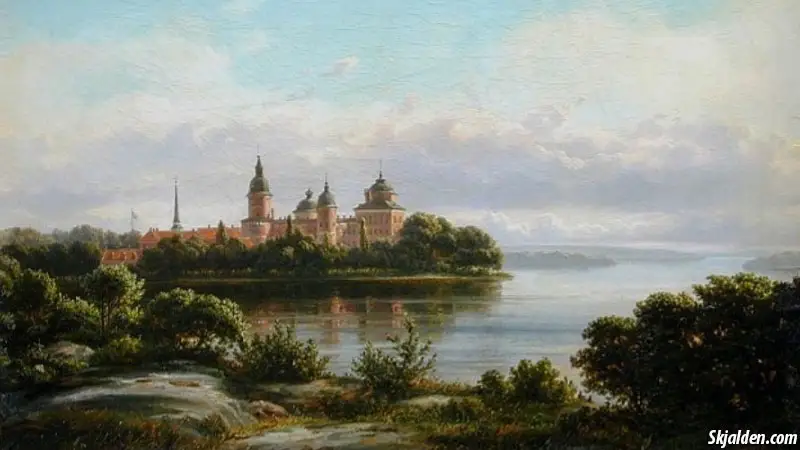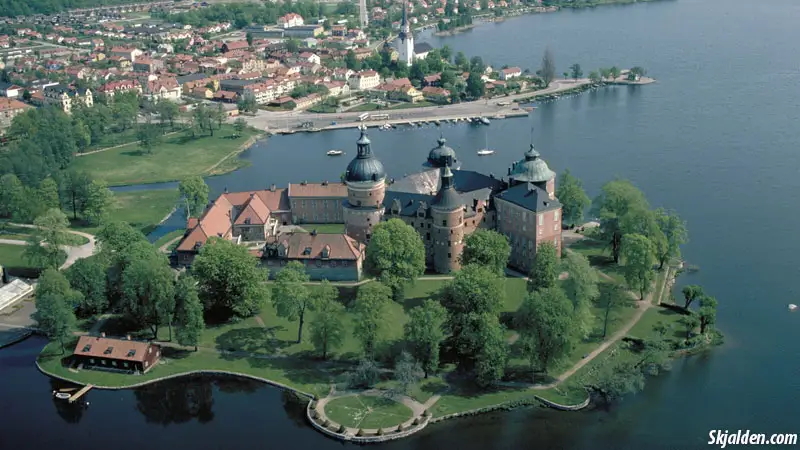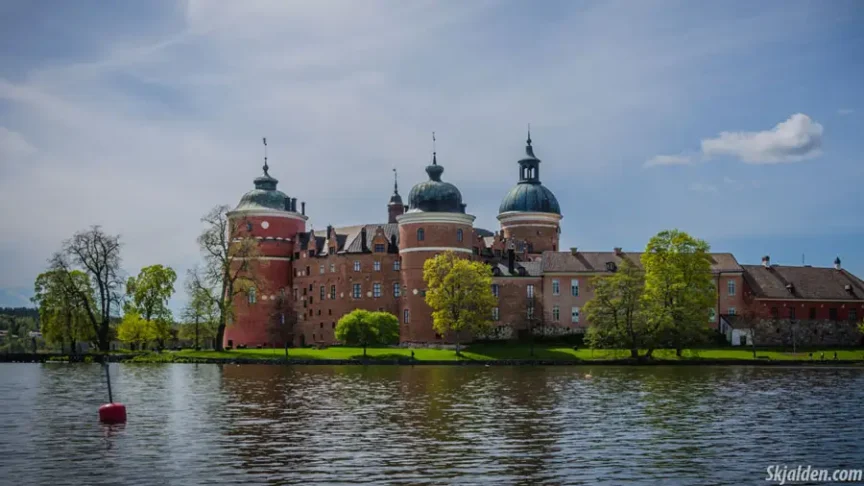Gripsholm Castle, located in the picturesque town of Mariefred, Sweden, is a remarkable piece of history stretching back to the 1370s. Founded by Bo Jonsson Grip and reshaped significantly during the Vasa dynasty, the castle is a showcase of architectural evolution and historical richness. From its early days as a medieval fortress to the cultural transformations under King Gustav III, the castle has been a central witness to Sweden’s evolving story.
Today, this historic castle welcomes the public, offering a chance to walk through centuries of Swedish history. Home to an impressive collection of portraits, Gripsholm Castle presents visitors with faces that shaped Sweden, spanning various time periods. The castle’s preserved architecture, set against the scenic backdrop of Lake Mälaren, provides a captivating experience for all who visit, blending its historical significance with educational and cultural exploration.
Gripsholm Castle in the 14th and 15th Centuries
The origin of Gripsholm Castle dates back to the 1370s, a period characterized by its medieval roots and political shifts. The castle’s founder, Bo Jonsson Grip, was not just a nobleman but also a key figure in the Swedish court. His decision to build Gripsholm was driven by the need for a powerful fortress in the region. The castle, with its robust structure and strategic location, played a crucial role in showcasing Jonsson’s influence and authority.
After Jonsson’s death, Gripsholm entered a new phase under Queen Margaret I. Her reign marked a significant transition as the castle became intertwined with the broader narrative of Nordic royalty. This shift was more than a change of ownership; it symbolized the castle’s growing importance in regional politics and diplomacy.
The 15th century brought further changes to Gripsholm. When Sten Sture the Elder, a revered Swedish statesman, acquired the castle, it started to transition from a military fortress to a noble residence. Sture’s influence is evident in the architectural enhancements and modifications he commissioned, reflecting the era’s evolving tastes and preferences in design. These changes were not merely aesthetic but also indicative of the castle’s shifting role from a defensive stronghold to a symbol of social status and power.
Under Sture’s guidance, Gripsholm began to embody a blend of fortification and elegance. The modifications made during this time laid the groundwork for future renovations and expansions. It was during these centuries that Gripsholm started to evolve from a medieval castle into a Renaissance residence, setting the stage for the significant transformations it would undergo in the subsequent Vasa era.
This period in Gripsholm’s history was crucial in setting its foundational character. The castle not only served as a reflection of the power and prestige of its owners but also as a witness to the dynamic shifts in Swedish political and social landscapes. As a result, Gripsholm Castle emerged from the 15th century not just as a building of stone and mortar but as a significant historical entity, poised to play a central role in the unfolding story of Sweden.
The 16th Century: Gripsholm and the Vasa Renaissance
The 16th century was a transformative era for Gripsholm Castle under the influence of the Vasa dynasty, particularly King Gustav Vasa. His acquisition of the castle in 1526 marked the beginning of an ambitious and comprehensive overhaul. King Gustav Vasa, a ruler known for his reformative and modernizing vision, saw Gripsholm not just as a residence, but as a symbol of the new Sweden he was shaping.
The medieval structure of Gripsholm, which had served its purpose for centuries, was largely demolished. This bold move was a clear statement of the changing times and the King’s intention to break away from the past. The reconstruction was entrusted to architects Henrik von Cöllen and Fredrik Nussdorffer, both renowned for their expertise. Their involvement ensured that the new design was not only modern and functional but also aesthetically aligned with the Renaissance style that was sweeping through Europe.
By 1537, a new Gripsholm Castle had emerged, showcasing a remarkable blend of defensive features and residential elegance. The castle was reimagined with an innovative layout, featuring four rounded towers connected by buildings. This design was both strategic, serving as a formidable defense structure, and symbolic, reflecting the power and prestige of the Vasa dynasty.
The interiors of the castle underwent significant changes as well. Rooms were designed to reflect the opulence and taste of the era, becoming spaces not only for living but also for showcasing art and hosting important political and social gatherings. Under Gustav Vasa, Gripsholm became a hub of cultural and intellectual activity, attracting scholars, artists, and dignitaries.
This period of transformation at Gripsholm was more than just a physical reconstruction; it was a redefinition of its identity. The castle transitioned from a medieval fortress to a Renaissance masterpiece, mirroring the broader changes occurring in Swedish society under the Vasa rule. The decisions and alterations made during this century set the stage for Gripsholm’s future, cementing its status as a landmark of architectural and historical significance in Sweden.

The 17th and 18th Centuries: Gripsholm’s Era of Elegance and Enlightenment
In the 17th and 18th centuries, Gripsholm Castle entered a golden age as both a royal residence and a cultural epicenter. This period was marked by a flourish of artistic and architectural developments that reflected the evolving tastes and aspirations of the Swedish monarchy.
Throughout the 17th century, Gripsholm became the preferred residence for several royal figures. Each monarch brought their unique preferences and styles, leading to diverse modifications and embellishments. The interiors were continually updated to reflect the latest trends in art and design. These changes were not merely cosmetic; they represented the castle’s ongoing adaptation to the needs and fashions of each era.
The 18th century saw Gripsholm further cementing its role as a cultural hub. The castle’s rooms and halls, adorned with exquisite art and luxurious furnishings, became venues for intellectual discussions, artistic exhibitions, and lavish gatherings of the era’s most influential figures. These events were not just social gatherings but also platforms for showcasing Sweden’s cultural and intellectual prowess.
King Gustav III’s reign in the late 18th century marked a pinnacle in Gripsholm’s history of cultural patronage. A passionate advocate of the arts, Gustav III initiated several significant projects at Gripsholm. The most notable among these was the construction of the theater in 1781. This theater was not just an architectural addition; it was a manifestation of the era’s enlightenment ideals. It became a venue for performances that reflected contemporary artistic trends and royal patronage of the arts.
Under Gustav III, Gripsholm also saw enhancements in its art collection, with acquisitions and commissions that reflected both Swedish and European artistic trends. The castle’s walls were adorned with paintings and tapestries that spoke of the sophistication and cultural aspirations of the Swedish court.

The 19th Century to Present: Gripsholm’s Journey to Public Heritage
As the 19th century dawned, Gripsholm Castle underwent a significant transformation, evolving from a royal residence into a cherished historical monument. This era marked a pivotal shift in the castle’s purpose and its relationship with the Swedish public.
The 19th century brought a heightened awareness of historical preservation and a growing interest in Sweden’s cultural heritage. Recognizing the importance of Gripsholm as a historical landmark, efforts were intensified to conserve its architectural integrity and protect its rich legacy. Restoration projects were undertaken with a focus on maintaining the authenticity of its structure and design, ensuring that future generations would be able to experience the castle’s historical ambiance.
One of the most noteworthy developments of this period was the establishment of the portrait collection in the late 19th century. This initiative transformed Gripsholm from a royal residence into a repository of national history. The collection, which began under the patronage of the Swedish state, gathered portraits of significant figures in Swedish history, encompassing various eras and styles. This collection became a visual narrative of Sweden’s past, showcasing the faces and stories of those who shaped the nation.
In the 20th century and beyond, Gripsholm continued to solidify its role as a public museum. It opened its doors to visitors from around the world, inviting them to explore the depths of Swedish history through its art and artifacts. The castle’s halls, once exclusive domains of royalty, now serve as galleries where the public can connect with centuries of Swedish culture and history.
Today, Gripsholm Castle stands not only as a beautifully preserved architectural gem but also as a vibrant cultural institution. It offers a unique window into Sweden’s past, housing an extensive array of historical artifacts, each telling a story of the nation’s journey through time. From its medieval origins to its current status as a public treasure, Gripsholm continues to be a focal point for cultural engagement and historical exploration, embodying the enduring spirit and heritage of Sweden.

Visiting Gripsholm Castle
Gripsholm Castle is a living museum, open to the public, where history comes alive in its halls and chambers. Here, visitors can explore an impressive collection of art, with a special focus on the portrait gallery. This gallery features prominent figures in Swedish history, providing a unique insight into the country’s cultural evolution. Each room in the castle has a story to tell, revealing the lifestyle and artistry of those who once lived there.
The castle also hosts various events and exhibitions throughout the year, adding to its dynamic atmosphere. These events often highlight aspects of Swedish history, culture, and art, making each visit a new experience. The location of the castle by Lake Mälaren adds to its charm, offering picturesque views and a tranquil environment for exploration and learning.
Gripsholm Castle is more than just a historical site; it’s a journey through Sweden’s past. It’s a place where visitors can connect with the history and culture of Sweden, making it a must-visit destination for anyone interested in exploring the legacy and beauty of this Nordic nation.
See prices and opening hours here.
Photo credit: Paulius Malinovskis
